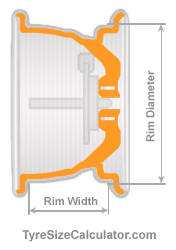Flexible tire sidewalls enable the tire to be mounted on slightly wider or narrower wheels/rims. This is the reason why each tire size has a rim width range on which the tire can be mounted.

Standard organizations, European Tire and Rim Technical Organization (ETRTO) and The Tire and Rim Association (TRA) established the rim width range for every tire size. If a rim is too narrow or too wide in relation to the tire width, performance of the tire is significantly reduced and the wheel or tire failure may occur.
Too wide rims improve handling but the ride is harsh because sidewalls do not bend enough on rough surfaces (over potholes and bumps). On the other side, too narrow rims may cause sidewall deformation when fast cornering. All these facts have to be taken into account when selecting adequate rims.
Standard organizations have also developed the measuring rim width for each tire size. The Measuring rim can be defined as the standardized rim for a single tire size (also referred to as "the Measuring Rim", "the Design Rim Width", "the Design Rim", etc.). Due to this fact all tire manufacturers are capable to measure their tires (literally) on the same rim size, when certain conditions for the measurement are met, like the tire pressure, the ambient temperature, the elapsed time from the moment the tire has been fitted on the rim to the measurement time. For example, all tire manufacturers measure the tire size 235/45R17 on the 8 inch wide rim.
When changing tires and/or wheels with their wider or narrower substitutes, the information about appropriate rims for a single tire size can be found in the tire manufacturer's rim conversion charts. There are several rim widths in these charts corresponding to a given tire size(more precisely, tire width), but only one is shown in bold. These rim widths or the approved/recommended rims have one rim width marked in bold that is referred to as the "measuring rim width". The term measuring rim refers to the wheel/rim upon the tire is measured. In other words, the nominal tire size becomes the real tire size when fitted on the appropriate measuring rim.
The tire width and the tire series(i.e., tire profile or tire aspect ratio) are closely related tire dimensions when we are talking about the tire to rim fitment. Almost every tire series has its own rim width/tire width ratio(specified by the tire associations). The ratio is used to calculate the measuring rim for the tire size. In other words, a lower aspect ratio means that you could use a wider rim for the same tire width.
Important information is that the tire width changes for about 5mm(2/10") for every 0.5"(inches) change in the rim width, in the approved rim width range for the tire size.
You can use our Wheel/Rim Size Calculator which shows the acceptable wheel/rim width range for any given tyre size in accordance with the ETRTO standards and Databooks of the leading tyre manufacturers. It gives You the answer to the question "What rims fit my car?"
Related articles:
- Rim width and tire width are two closely related sizes. See Tire width for a wheel/rim size chart and Tyre Size for Rim Size/Width Calculator - What's the best tyre size for my rim?
- See other Tire/Wheel charts.
- Check out Tire/Wheel calculators.
- Find out more about Tires and Wheels.
